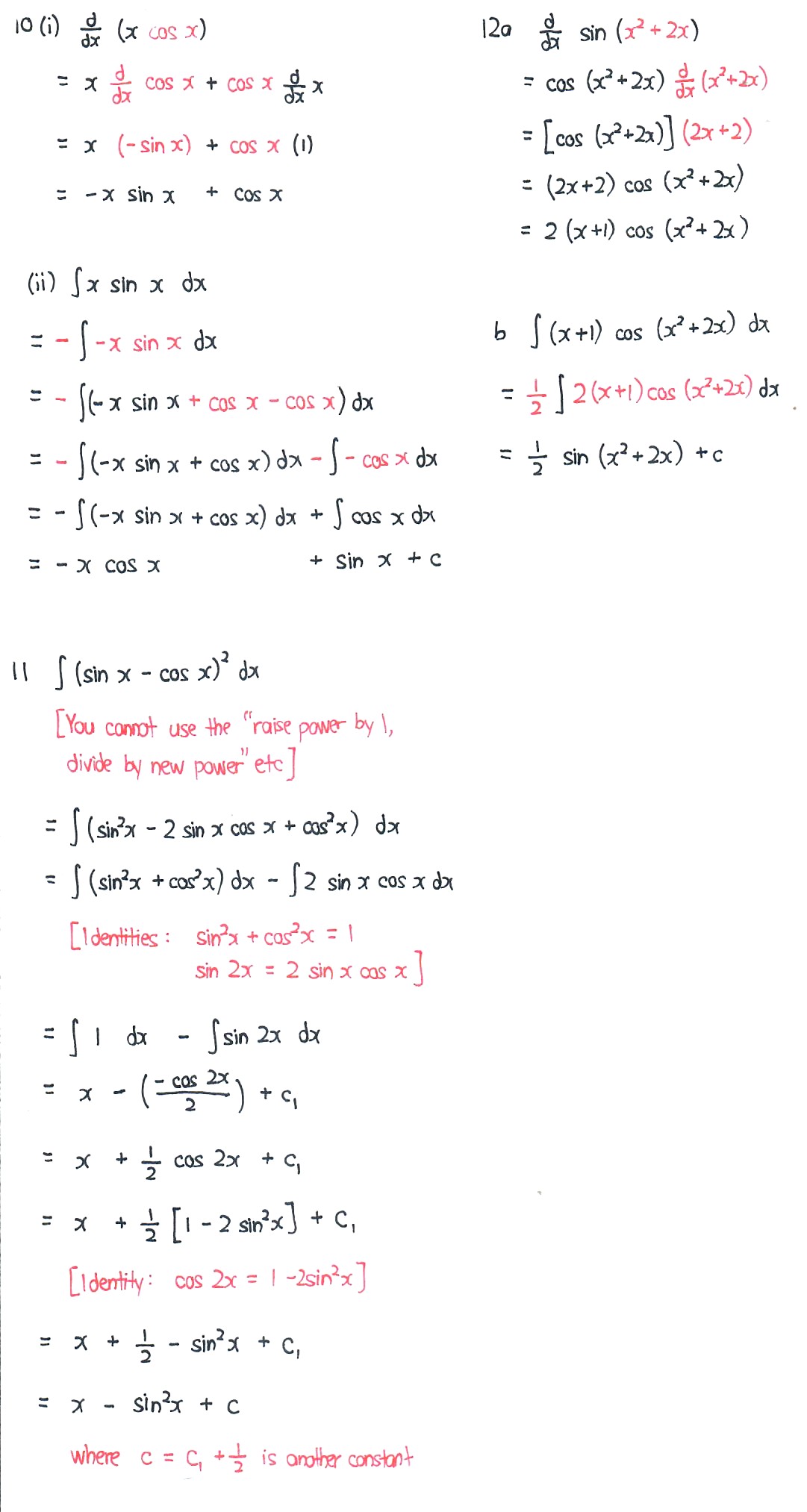Eric Nicholas K's answer to Sonia's Secondary 4 A Maths Singapore question.
done
{{ upvoteCount }} Upvotes
clear
{{ downvoteCount * -1 }} Downvotes
Hi Sonia!
For the differentiation part, we need to continue to use chain rule, product rule and quotient rule as and when necessary.
For the integration part, we need to use the results from the previous part and manipulate the given expression to obtain the expression found during differentiation. This facilitates easy integration of the required term.
Take for example, in Q10(ii), I input a '-' sign first to make x sin x become -x sin x, followed by the introduction of the filler term 'cos x' so that I an use the results in part (i) to integrate the expression; the other term cos x which is left behind can be integrated easily.
In Q11, we cannot integrate such terms by raising power by 1, dividing by new power and multiplying the denominator by the derivative of the chain. 'Chain rule' for such cases works only if the term inside the brackets is LINEAR. Also, there is no product rule and quotient rule for integration, at least in your syllabus.
For the differentiation part, we need to continue to use chain rule, product rule and quotient rule as and when necessary.
For the integration part, we need to use the results from the previous part and manipulate the given expression to obtain the expression found during differentiation. This facilitates easy integration of the required term.
Take for example, in Q10(ii), I input a '-' sign first to make x sin x become -x sin x, followed by the introduction of the filler term 'cos x' so that I an use the results in part (i) to integrate the expression; the other term cos x which is left behind can be integrated easily.
In Q11, we cannot integrate such terms by raising power by 1, dividing by new power and multiplying the denominator by the derivative of the chain. 'Chain rule' for such cases works only if the term inside the brackets is LINEAR. Also, there is no product rule and quotient rule for integration, at least in your syllabus.
Date Posted:
5 years ago
Hi eric! Thank you for your explanations but How do you integrate (b)? I’m not clear..
Typically in the first part, you differentiate expression A to get expression B.
In the second part, the question asked is very similar looking to expression B. We need to make some manipulations to get exactly expression B so that we can perform integration easily to obtain expression A.
————
In the case of Q12, the difference between the differentiated expression in part a and the question in part b is a multiplication factor of 2. Because the question does not contain a ‘2’ but your differentiated expression in part contains ‘2’, we need to introduce this ‘2’ ourselves just so as to obtain the exact same expression in part a. To compensate, we need to multiply 0.5 outside.
————
It’s something like completing the square - we introduce a term to complete the square but then must compensate by subtracting away the same introduced term later.
————
I will later explain in greater detail when I have access to writing materials when I return after 1 am.
In the second part, the question asked is very similar looking to expression B. We need to make some manipulations to get exactly expression B so that we can perform integration easily to obtain expression A.
————
In the case of Q12, the difference between the differentiated expression in part a and the question in part b is a multiplication factor of 2. Because the question does not contain a ‘2’ but your differentiated expression in part contains ‘2’, we need to introduce this ‘2’ ourselves just so as to obtain the exact same expression in part a. To compensate, we need to multiply 0.5 outside.
————
It’s something like completing the square - we introduce a term to complete the square but then must compensate by subtracting away the same introduced term later.
————
I will later explain in greater detail when I have access to writing materials when I return after 1 am.



